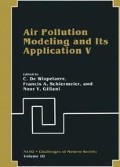Abstract
The atmospheric dispersion of a large, heavier-than-air gas release is affected by several physical phenomena that either do not occur or are unimportant in neutrally buoyant and trace gas releases. These include turbulence damping due to stable density stratification of the heavy gas cloud, alteration of the ambient velocity field due to gravity flow and the source momentum flux in a large release and, for cold gas releases, the effects of heat flow from the ground on cloud buoyancy and turbulence. Furthermore, the time scale of interest for a particular heavy gas release may differ considerably from the long term dose concerns associated with typical atmospheric pollutants. For example, in combustible gases releases, one is concerned with the instantaneous concentration, while in a toxic gas release one might be concerned about doses over minutes to hours. In order to make meaningful predictions of the size and duration of the hazardous concentration region from a large, heavy gas release, all of the significant physical phenomena need to be included and the appropriate concentration averaging time needs to be used.
Access this chapter
Tax calculation will be finalised at checkout
Purchases are for personal use only
Preview
Unable to display preview. Download preview PDF.
References
Chan, S.T., 1983, “FEM3 — A Finite Element Model for the Simulation of Heavy Gas Dispersion and Incompressible Flow : User’s Manual”, UCRL-53397, Lawrence Livermore National Laboratory, Livermore, CA.
Chan, S.T., H.C. Rodean, and D.L. Ermak, 1984a, “Numerical Simulations of Atmospheric Releases of Heavy Gases Over Variable Terrain”, Air Pollution Modeling and its Application III, Plenum Press, pp. 295 – 341.
Chan, S.T., and D.L. Ermak, 1984b,”Recent Results in Simulating LNG Vapor Dispersion over Variable Terrain”, Atmospheric Dispersion of Heavy Gases and Small Particles, Spring-Verlag, pp. 105–114.
Dyer, A.J., 1974, “A Review of Flux-Profile Relationship”, Boundary-Layer Met., 7, pp. 363–372.
Gerald, C.F., 1970, Applied Numerical Analysis, Addison-Wesley, Menlo Park, CA.
Gifford, F.A., 1976, “Turbulent Diffusion — Typing Schemes : A Review”, Nuclear Safety, 17, No. 1, pp. 68–86.
Golder, D., 1972, “Relations Among Stability Parameters in the Surface Boundary Layer”, Boundary-Layer Meteor., 3, pp. 47–58.
Koopman, R.P., R.T. Cederwall, D.L. Ermak, H.C. Goldwire, Jr., J.W. McClure, T.G. McRae, D.L. Morgan, Jr., H.C. Rodean, and J.W. Shinn, 1982, “Analysis of Burro Series 40-m3 LNG Spill Experiments, J. of Haz. Materials, Vol. 6, Nos. 1–2, pp. 43–83.
Lettau, H.H., 1979, “Wind and Temperature Profile Production for Diabatic Surface Layers Including Strong Inversion Gases”, Boundary-Layer Meteor., 17, pp. 443–464.
Morgan, D.L. Jr., L.K. Morris, and D.L. Ermak, 1983, “SLAB : A Time-Dependent Computer Model for the Dispersion of Heavy Gases Released in the Atmosphere”, UCRL-53383, Lawrence Livermore National Laboratory, Livermore, CA.
Morgan, D.L. Jr., S.T. Chan, and L.K. Morris, 1984, “The Phenomenology and Modeling of Heavy Gas Dispersion”, UCRL-89460, Lawrence Livermore National Laboratory, Livermore, CA.
McRae, T.G., 1985, “Analysis and Model/Data Comparisons of Large-Scale Releases of Nitrogen Tetroxide”, UCID-20388, Lawrence Livermore National Laboratory, Livermore, CA.
Zeman, O 1982, “The Dynamics and Modeling of Heavier-than-Air, Cold Gas Releases”, Atmos. Environ., 16, pp. 741–751.
Author information
Authors and Affiliations
Editor information
Editors and Affiliations
Rights and permissions
Copyright information
© 1986 Springer Science+Business Media New York
About this chapter
Cite this chapter
Ermak, D.L., Chan, S.T. (1986). A Study of Heavy Gas Effects on the Atmospheric Dispersion of Dense Gases. In: De Wispelaere, C., Schiermeier, F.A., Gillani, N.V. (eds) Air Pollution Modeling and Its Application V. NATO · Challenges of Modern Society, vol 10. Springer, Boston, MA. https://doi.org/10.1007/978-1-4757-9125-9_46
Download citation
DOI: https://doi.org/10.1007/978-1-4757-9125-9_46
Publisher Name: Springer, Boston, MA
Print ISBN: 978-1-4757-9127-3
Online ISBN: 978-1-4757-9125-9
eBook Packages: Springer Book Archive

